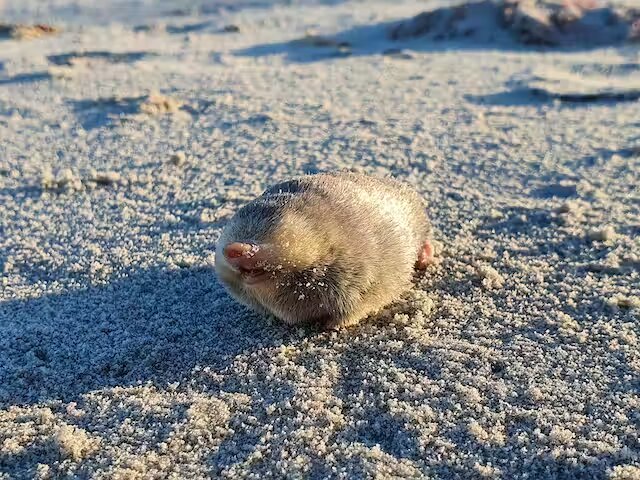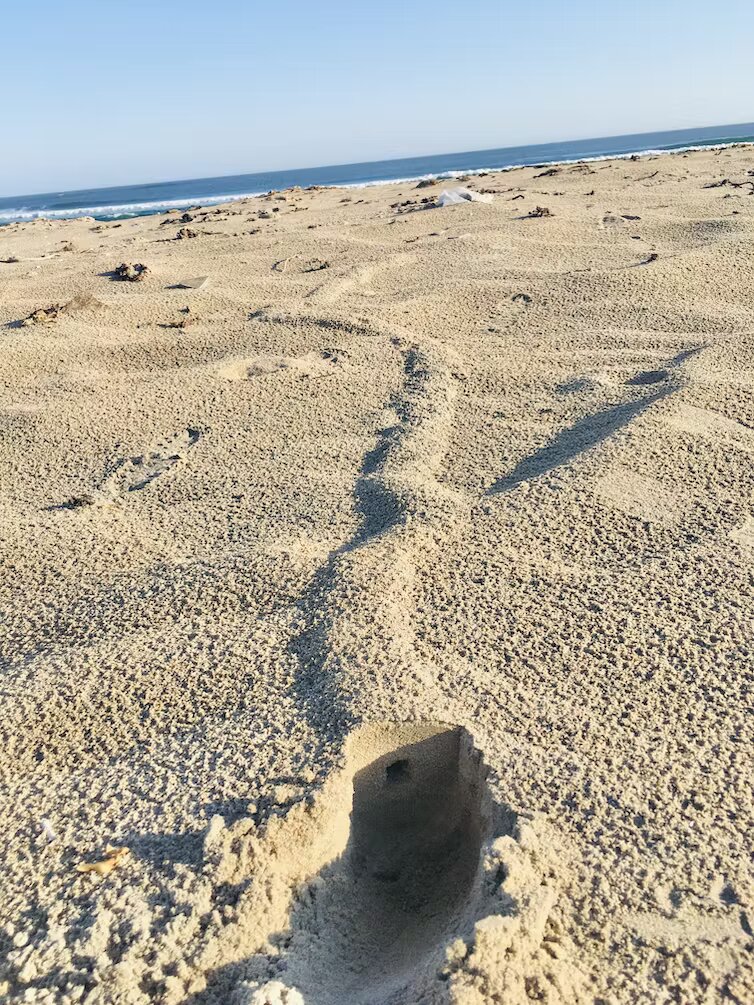THE CONVERSATION
Golden mole that swims through sand is rediscovered in South Africa after 86 years

Scientists found De Winton’s golden mole by tracking its environmental DNA through the sand.
The De Winton’s golden mole was last seen in 1937 on the northwestern coast of South Africa, and later declared officially lost. This iridescent blind mole with hearing superpowers evades contact with humans and “swims” through sand dunes, making it very difficult to locate. But in November 2023, a team of conservationists and geneticists from the Endangered Wildlife Trust, Stellenbosch University and the University of Pretoria found the mole after tracking its environmental DNA through the dunes. Molecular biologist Samantha Mynhardt was part of the team that found the mole. The Conversation asked her about it.
How did this mole species stay ‘lost’ for so long?
Golden moles are elusive little animals that spend nearly their entire lives underground. They are very seldom seen by humans. Some species will occasionally come to the surface to forage on insects, typically only at night. In most cases, the only sign of golden mole activity is a raised ridge on the surface of the ground, indicating a shallow tunnel underneath. For the sand-dwelling species, such as De Winton’s golden mole (Cryptochloris wintoni), even these ridges are hard to find, since the subsurface tunnels collapse in the soft sand.
De Winton’s golden mole has been severely affected by diamond and mineral mining activities on the South African west coast and we suspect that the population has declined substantially over the past century. The species was last detected in 1937 at the small harbour town of Port Nolloth on the north-western coast of South Africa. For the next 86 years, it eluded scientists, probably because of difficulties in locating and trapping it and because a similar looking mole, Grant’s golden mole (Eremitalpa granti), was still present in the area.

A tunnel used by the De Winton’s golden mole in Port Nolloth, South Africa. Image: Samantha Mynhardt,
How long does a species have to be missing before it’s said to be extinct?
Lost species are those that have been lost to science for at least 10 years, and often much longer. Extinct species are different: a species is presumed extinct when it has not been detected for more than a generation of its lifetime, despite exhaustive surveys of its habitat. Although De Winton’s golden mole had not been seen in over 80 years and was presumed extinct, no comprehensive searches had taken place and therefore it was still considered “lost”.
How did you rediscover the mole?
In 2020 we conducted a pilot study in Lambert’s Bay, where De Winton’s sister species, the endangered Van Zyl’s golden mole (Cryptochloris zyli), lives. This study showed that our techniques for detecting golden moles would work.

Jessie the border collie and the human team who discovered the lost De Winton’s golden mole. From left: Esther Matthew, Cobus Theron, Samantha Mynhardt and JP le Roux. Image: Nicky Souness,
In July 2021, we began our expedition along the west coast to Port Nolloth, the only site where De Winton’s golden mole had ever been found. We surveyed sites along a 300km stretch of coastline, from the Groen River mouth northwards to Alexandra Bay. Our team of five, including border collie Jessie and I, conducted surveys on foot for a week, exploring 18km of dune habitat every day. Jessie had obviously never encountered a De Winton’s golden mole before, and was not trained to sniff out the species. However, she had been trained on other golden moles and we knew she would indicate to us if she picked up the scent of these more common species. When the team found golden mole tunnels, and Jessie wasn’t interested, we had a good idea that we had found something “new”.
How did you collect the mole’s environmental DNA?
We collected over 100 soil samples from the insides of their underground tunnels. Animals shed their DNA into their environment, typically in the form of skin cells, hair, excretions and secretions. This environmental DNA (eDNA) is so tiny it is invisible to the human eye. We later extracted the eDNA from the soil in the lab, and barcode-sequenced it. The DNA sequence matched a De Winton’s reference sequence, which had been generated in 2010 from a museum specimen housed at the Ditsong National Museum of Natural History.
What made you go looking for this mole?
I had been looking into alternative non-invasive means of studying golden moles, having faced the immense challenge of trapping them in nature to collect genetic samples. The Endangered Wildlife Trusts’s Drylands Conservation Programme received funding from Re:wild, a non-profit organisation founded by a group of renowned conservation scientists together with Leonardo DiCaprio, who had listed De Winton’s golden mole as one of the world’s Most Wanted Lost Species. So we teamed up to search for this mole.
Though many people doubted that De Winton’s golden mole was still out there, we had good faith that the species had not yet gone extinct. We were convinced it would just take the right detection method, the proper timing, and a team passionate about finding it. We have now tapped into a way of finding other lost or imperilled species through eDNA tracking.
How many De Winton’s golden moles still exist, do you think?
Golden mole activity was particularly abundant on the beach at McDougal’s Bay in Port Nolloth, so it is likely there is a healthy population there. We also detected De Winton’s golden mole presence at additional sites, indicating that the species may be more widespread. Unfortunately we are not able to estimate the population size at this stage, but future research should aim to do so.
Although we were hopeful of finding eDNA evidence of De Winton’s golden mole, we did not expect to see a live animal. But we did capture one golden mole at Port Nolloth, and confirmed that this was a De Winton’s golden mole after taking swabs and sequencing the DNA. We’ve since found a second De Winton’s golden mole in the same area.
We are incredibly excited about this discovery. The rediscovery of De Winton’s golden mole offers us the chance to learn more about this fascinating and poorly understood small mammal. It also offers an opportunity to reinvigorate conservation efforts for threatened golden moles, and gives us hope of finding other species presumed to be extinct. DM
This story was first published on The Conversation. Samantha Mynhardt is a Molecular biologist at Stellenbosch University.




















 Become an Insider
Become an Insider
Great stuff!! Thanks for the effort.
I saw such sand tracks identicsl to this one in the dunes at Cape Nature Rocherpan and wondered how a mole like creature underground could survive in those dunes. Maybe this is the answer! Great article!!!
I saw one of these golden moles in 2017, while travelling on the R45 from Velddrif to Langebaan. It was on the edge of the tarmac, looking so vulnerable and helpless, and all the cars were swerving to avoid it. I never knew what it was and have always wondered if the poor thing survived.
They are such wonderful and beautiful little animals – nature/evolution has provided that they are so perfectly adapted for their lifestyle. Thank you for your efforts on their/our behalf. Let us hope we can provide a sanctuary for them soonest.
What an exciting discovery! I would have loved to become a naturalist ever since I have been watching David Attenborough, but didn’t know that this existed.
Please send more photos. Does this animal not have eyes at all? It appears like that on the photo.
How nice to read some good news for a change! Well done to the team. It must have been hard work trudging around in those dunes, but well worth it.